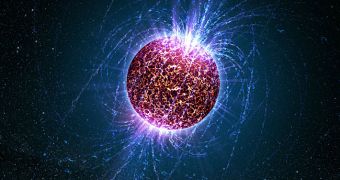Once believed to be a type of black holes, neutron stars usually form during the late stages of a star's life. They have masses ranging from 1.4 to 2.1 times that of the Sun and compact the matter in a volume from 20 to 40 kilometers in diameter, causing all matter that falls on their surface to disintegrate into elementary particles. It is believed that protons and electrons inside them merge to create neutron particles, thus their whole mass is represented by neutrons.
Most theories regarding their structure suggest that they have a thin atmosphere about one meter deep, followed by a solid crust about 1.6 kilometers thick formed of a mix of atomic nuclei and elementary particles. Under the solid crust lies a liquid neutron core that gets even denser as one advances towards the center of the neutron stars, which is believed to be formed of an ultra-dense state of matter, frequently referred to as neutronium.
Commonly known as pulsars, due to the fact that they emit short pulses of powerful X-ray radiation, neutron stars are scattered all over the galaxy. Recently the closest neutron star has been discovered in the Ursa Minor constellation, about 250 to 1000 light years away. Named Calvera, the newly discovered neutron star is part of a neutron star collection known as 'The Magnificent Seven', formed of isolated neutron stars, meaning their radiation emissions are powered by the rotation of the stars.
Neutron stars form during the supernova explosion that takes place at the end of a star's life. Due to Newton's third law of motion, as the explosion takes place debris is ejected outwards while at the same time the ejected outer layers compress the star's core. Usually neutron stars have masses from 1.4 to 2.1 that of the Sun, followed by their cousins the quark stars that could pack a mass up to 3 solar masses, while everything heavier than 5 solar masses would result in a gravitational collapse, meaning that the other fundamental forces of matter are not able to balance the powerful gravitational field, and create black holes.
They rotate their whole mass at incredible speeds and have a spin time ranging from 10 milliseconds to 30 seconds. The rotation speed is generated during the neutron star formation and gradually drops as time goes by.
However, though the Calvera neutron star was pinpointed during observations made in the 1990's and 2006, by studying the pulses of X-ray radiation it gave off, only recently has it been recognized as one, due to the observations made with the Chandra X-ray Space Telescope that proved that indeed the source of the radiation was a point-like object that is similar to a neutron star.
Catalogued as a neutron star, Calvera radiated bright X-ray light and a faint visible light, though it is still unknown what type of neutron star it represents, which poses some kind of mystery because it could be the first star of its kind ever discovered, as it does not emit radio beams similar to those observed in the rotating pulsars.
A second mystery related to the Calvera is its location, somewhere high above the material disk of the Milky Way. However, scientist believe it is like an isolated neutron star, meaning it formed in the wake of the supernova explosion of a star and did not travel a great distance from the position of the original star.

 14 DAY TRIAL //
14 DAY TRIAL //